Shelves for the kitchen: types and selection

As you know, fashion is cyclical, and this is also true when it comes to interior decoration. Today kitchen shelves are gaining popularity again. However, this decor element has returned in a new guise, or rather, variety. Manufacturers offer products of various shapes, sizes, styles. It remains only to choose the right one.
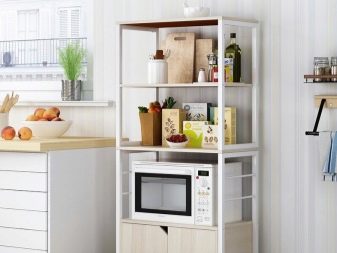
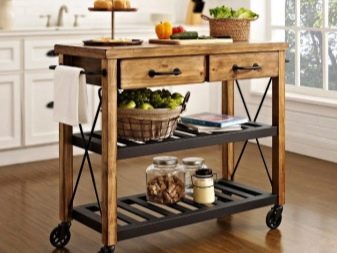
What is it and why are they needed?
A shelf is a type of furniture designed for storing food, dishes, vegetables and other kitchen utensils. The shelves do not have doors or walls. They are a structure consisting of several shelves located one above the other (floors) and united by racks.
The shelves are characterized by functionality and spaciousness, but at the same time they do not take up much space and visually do not clutter up the room.
Due to the absence of walls and ergonomics, the shelves can also be used for room zoning, for example, separating the kitchen area from the dining room, the dining room from the living room.
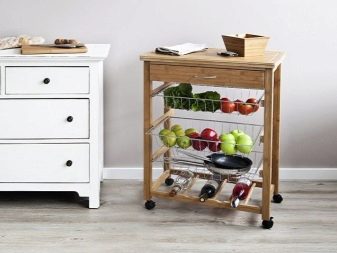
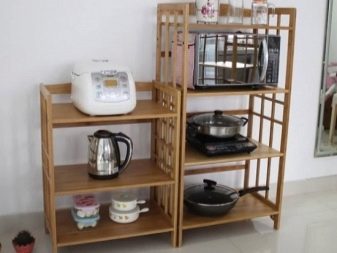
Shelves are recommended in those interiors where functionality should be provided in limited space... However, even in spacious kitchens, this piece of furniture will take its rightful place, becoming the finishing touch of the interior.
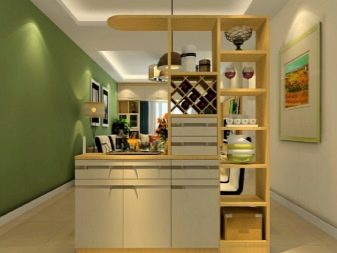
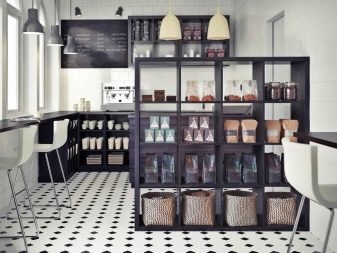
Advantages and disadvantages
The advantage of the shelf is its mobility - you can find models of various sizes on sale. Even the smallest area of the kitchen can be turned into a useful one by choosing the appropriate size whatnot.
Due to the absence of walls, whatnot does not take up much space. At the same time, it is very functional: many shelves allow you to place household appliances and dishes on them.You can store both single large items (for example, placed on a microwave shelf), and many small ones, placing them in special boxes.
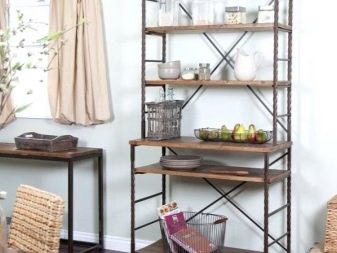
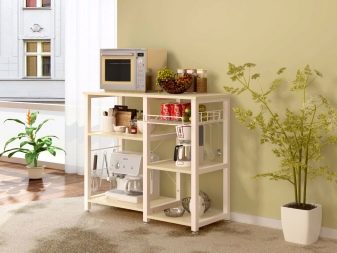
Thanks to the open design, the shelf does not clutter up the room, and some models, for example glass ones, even visually increase the area of the kitchen. The shelves do not interfere with the penetration of light into the room and allow you to visually zone the kitchen.
A significant drawback of such furniture is rapid contamination of shelves and items stored on them. This is understandable, because the shelves are not protected by anything, so dust quickly settles on them, water stains, splashes of fat fall.
Considering that there are usually quite a lot of items placed on the shelves, cleaning requires a significant investment of time and effort.
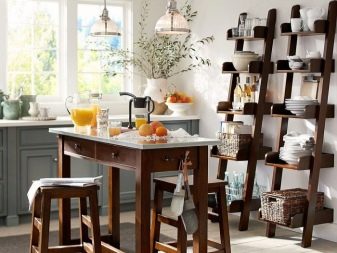
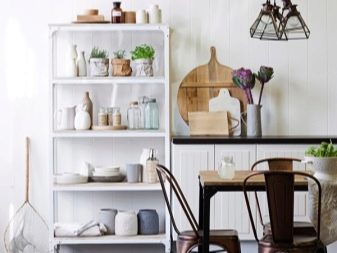
Types of structures
The shelf can be square, rectangular or oval. In small spaces rationally use corner structures that "do not eat up" the usable space and allow functional use of the corners. Square shelves are also considered comfortable and roomy. The narrow version will also be a good solution for small spaces, corners, walls. Circle-shaped counterparts require a lot of space.
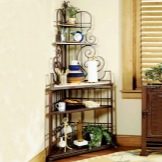
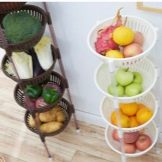


Different designs also differ in the types of fastening. Furniture can be screwed on to the wall or floor. There are also small mobile models. They are equipped with transport wheels and often have a handle on the side for convenience.
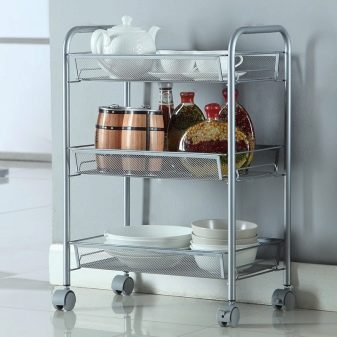

Some models of whatnots differ fixed position of shelves and baskets. But most modern designs assume the variability of their location: the hostess herself chooses how many and at what distance the shelves of the shelf will be located.
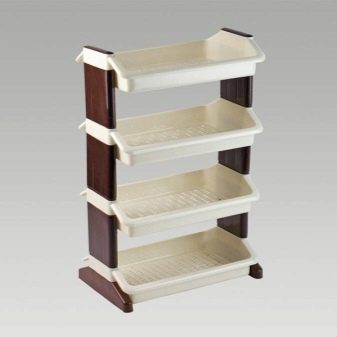
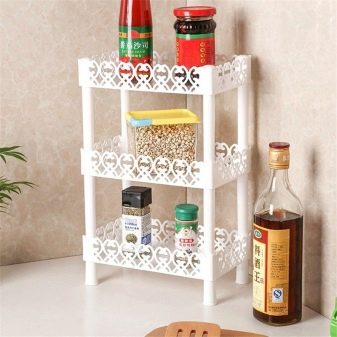
Large and roomy are usually floor or wall types. In any case, with their legs they stand on the floor, fixing themselves to it or to the wall. Variants of hinged shelves are widespread, however, due to the mounting method, the manufacturer is still limited in the choice of dimensions and material (weight) for their manufacture. As a rule, hinged options are made for 2-4 shelves, and lightweight materials are used as supports, up to decorative ropes.
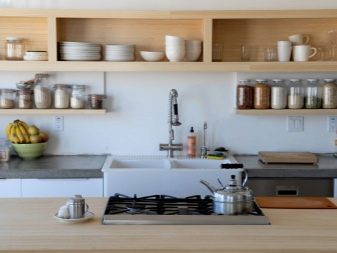

There are models that are put to the table and look like an extension of it. As a rule, they are the same height as the table or slightly exceed it. Finally, you can find furniture that is installed on the kitchen table on sale. This bookcase looks like a small slide without walls. It is convenient to keep sweets, bread bin, dishes on it.
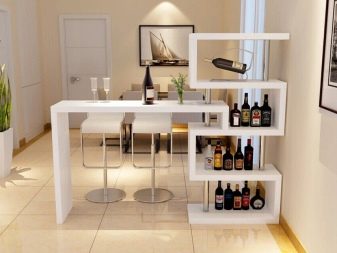
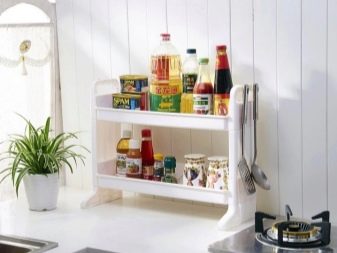
Depending on the design features, three types of whatnots can be distinguished.
With open shelves
A well-known design, which basically has 4 supports and the required number of shelves. Such shelves do not have side walls, everything displayed will be in sight, so you will have to carefully monitor the order. As a rule, such designs are used to a greater extent for decoration. Jars of cereals, beautiful boxes with various small things will be appropriate. Dried flowers, fruit vases will also perfectly complement open shelves and the kitchen as a whole.
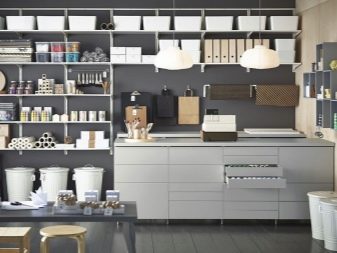
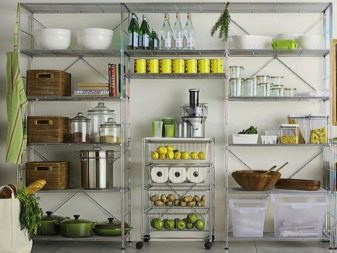
With drawers and baskets
These shelves are equipped with shelves with drawers or baskets. Only the top shelf of the furniture can be used as open. Such structures are not made high, otherwise their use will be inconvenient, and such furniture will look massive... In principle, anything can be stored in such a design. For placing food, it is better to choose boxes with perforations or slots in the surface.
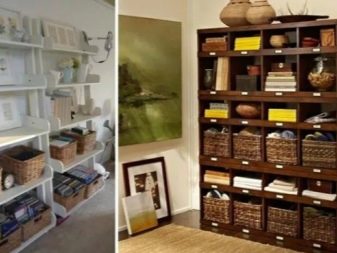
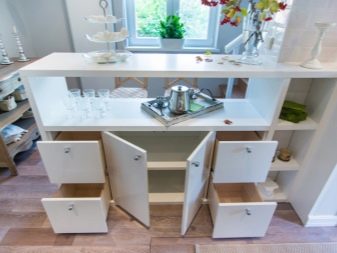
Combined
These designs combine open shelves and drawers. The latter (for stability, whatnots) are placed in the lower part, and above them there are 2-3 rows of open shelves. Since the boxes are located at the bottom, you have to lean towards them, so it is logical to put in them those items that you rarely use.
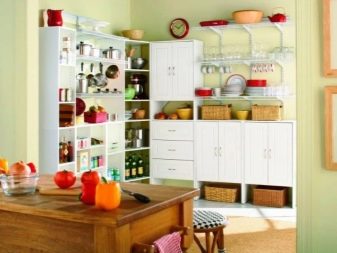
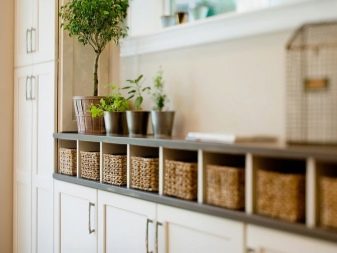
Manufacturing materials
Shelves can be made from different materials.
Wood
Wood is environmental friendliness (furniture does not cause allergies, does not emit toxins), style, harmonious look in almost any interior. Natural wood immediately creates an atmosphere of special comfort, home warmth in the room.
The wooden model will be especially successful in rustic, classic, Scandinavian interiors. The design is reliable and durable, if necessary, you can update and slightly change the design of the product thanks to the use of varnishes, wood stains, special dyes for wood.

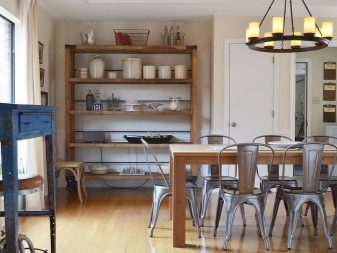
At the same time, wooden structures are unstable to moisture and high temperatures. The shelf must be varnished, it should not be placed near the sink and refrigerator (the latter can give condensation), gas stoves, ovens. For long-term operation and preservation of an attractive appearance, the shelves will periodically have to be restored: sand the aged layer of varnish, apply a new one. Also among the "minuses" - heavy weight, difficulty in transportation.
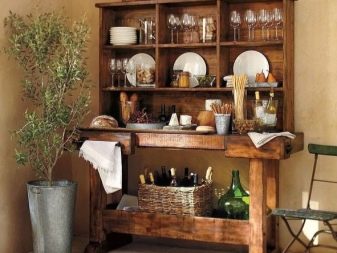
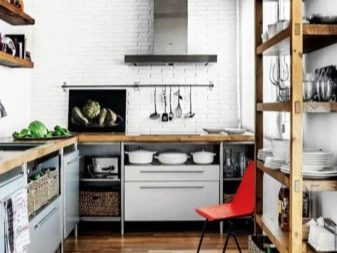
If stains get on wood, it is important to remove them as soon as possible, so that they do not have time to eat into the material. For care aggressive detergents will not work, The best way to get rid of stubborn dirt is with soapy water. The washed bookcase should be wiped dry immediately.
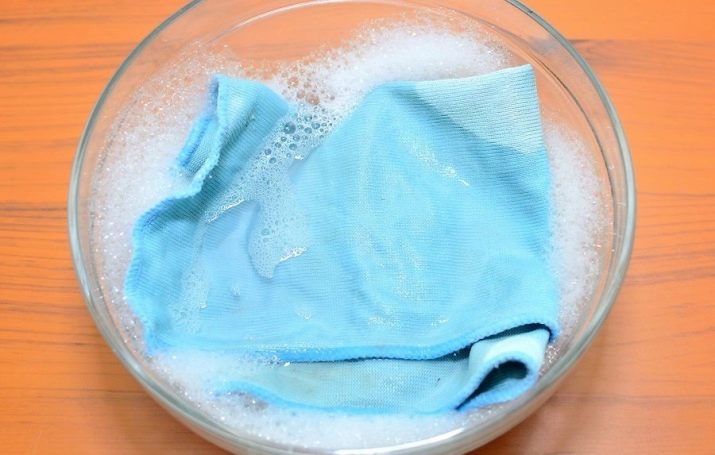
Chipboard, MDF
These composite materials are sometimes called cheaper "substitutes" for wood, but visually they do not look so respectable. Nevertheless, it is a very popular furniture option. It is important to control what type of slabs the shelf is made of, since low-grade raw materials can contain dangerous amounts of formaldehyde resins. Preference should be given to slabs, the quality of which meets European standards.
If we compare the safety of chipboard and MDF, then the second will be less dangerous. The adhesive composition here is harmless lignin. However, the cost of products from MDF is significantly higher than analogues from chipboard.
Since the kitchen is a place of high humidity, it is worth choosing furniture with a laminated coating.

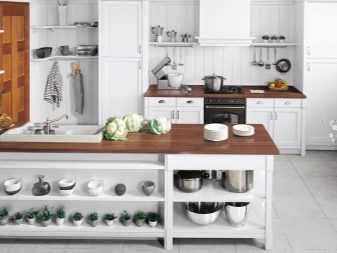
Metal
The metal is characterized by strength, durability, environmental friendliness The model should be chosen made of stainless steel, resistant to high humidity. Many varieties have mesh baskets, due to which the structure is lightweight and overall looks quite light, does not clutter up the space. Metal shelves look especially good in high-tech, minimalist interiors. Analogs with forged elements will successfully fit into classic designs.
Many metal shelves are heavy, so it is better to invite two people to rearrange the product, since it is recommended to raise the furniture above the floor, and not to carry it over it.
Metal products are not the best option for a home with small children. It is recommended to choose whatnots without sharp corners and protruding elements: they are less traumatic.
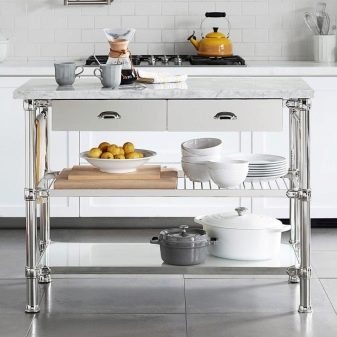
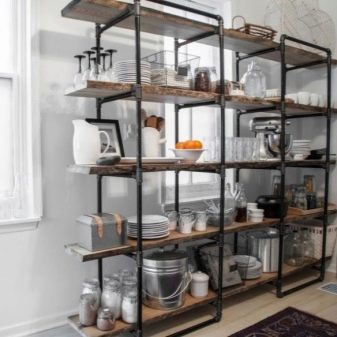
Plastic
The material, resistant to the influence of moisture, is characterized by ease of maintenance, affordability, many design options, and low weight. It is better to choose a model with perforated baskets so that moisture does not accumulate in them. A plastic shelf is appropriate in modern interiors, however, in general, the structure is not durable.
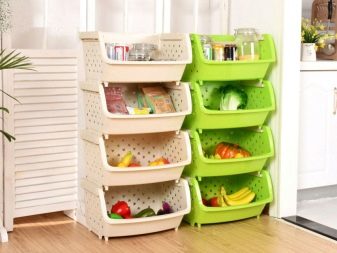

Glass
Tempered glass is used for the production of whatnots. It is characterized by increased strength and, even if damaged, will not crumble into hundreds of small fragments. Glass shelves look stylish and allow you to visually expand the room. The material is not afraid of moisture, but splashes or streaks become immediately noticeable, which makes it look sloppy.
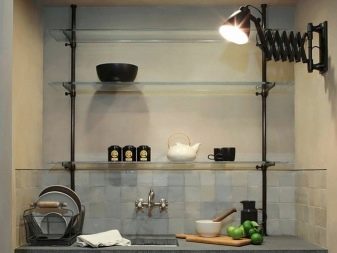
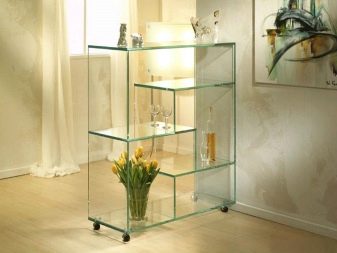
How to choose?
When choosing whatnot, you should take into account the peculiarities of the kitchens. For cramped rooms, you should choose designs in light shades; glass models are also suitable. Furniture should be as lightweight as possible, without massive and wide elements.
As for the shape of the furniture, corner models are usually recommended for small-sized kitchens. With a linear arrangement of furniture, you can consider the option of installing a rectangular shelf.
Moreover, if the layout allows, it is advisable to place the structure not along, but across the wall.
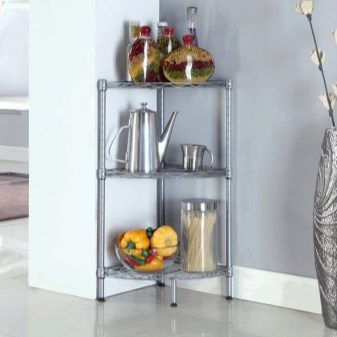
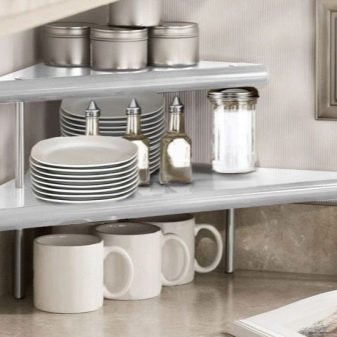
In interiors decorated in the spirit of minimalism or hi-tech, in a word, where straight lines and laconicism reign, square and rectangular models of whatnots will be successful.
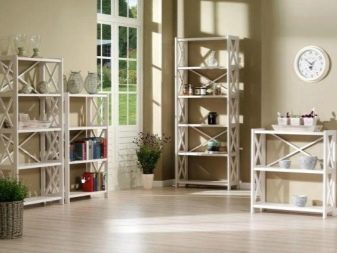
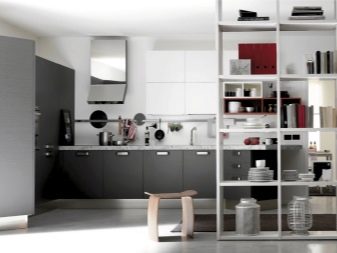
If the design is dominated by rounded lines, streamlined and smooth shapes, then it is worth choosing round and rectangular shelves for them.
Tall models should be not only functional, but also decorative elements of the interior. They occupy a significant part of the kitchen, so it is recommended to supplement the shelves with elegant dishes and trifles. For more practical use, low structures are suitable. The upper open shelf can be used for microwave ovens, while the lower closed drawers store everything you need.
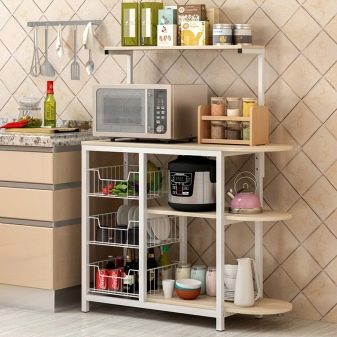
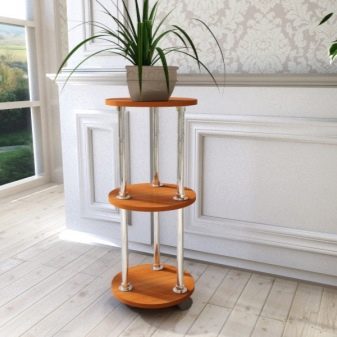
In addition to practicality, you should also consider how the shelf fits into the overall design of the kitchen. For rooms in Provence style, rustic and ethnic styles, wooden products are suitable. Design - from strict and laconic to creative. However, it is better to maintain the "golden mean" - simple in shape products with decor in the form of carved elements. For country and Provence, you should choose models that combine wood and forged parts.
So, a wooden shelf with metal supports will be successful.
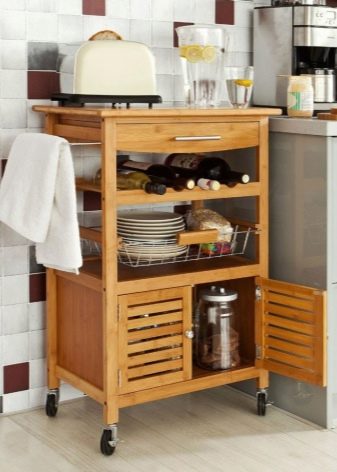
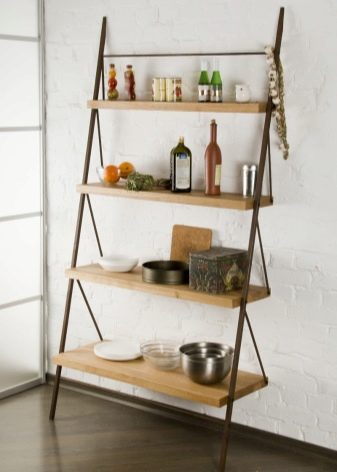
Wooden models will also fit well into the classic interior, while it is recommended to choose whatnots 1-2 tones darker than the shade of the main furniture. A luxury and stylish element of a classic interior will be a bookcase with an antique effect or a heavy forged model.
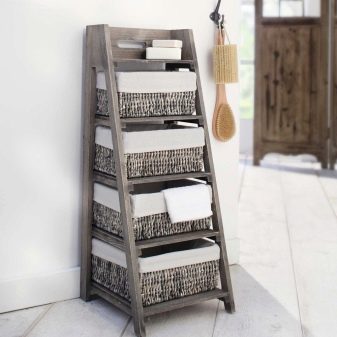
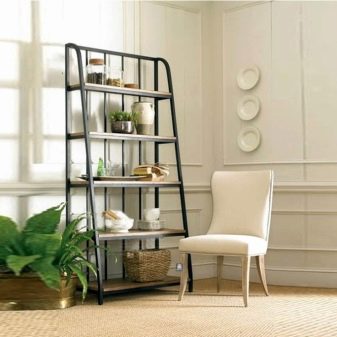
For light interiors, including summer cottages, wooden or metal products with wicker baskets. They are especially successfully combined with rattan furniture and textiles made from natural materials.
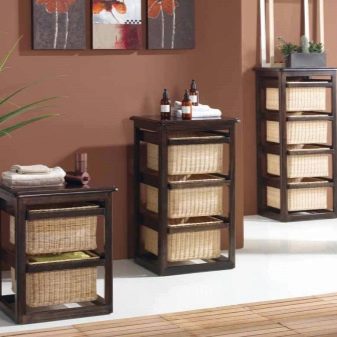
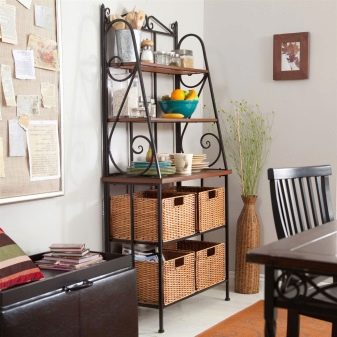
For style kitchens modern with limited finances, you can use constructions from MDF and chipboard. The design and shade should be matched to the tone and style of the main furniture in the kitchen (as accurately as possible). The goal here is not to draw attention to the shelf, but to "push" it into the general view of the kitchen, to use it only as a storage system... A possible option is plastic models, which also do not have bright, conspicuous details.
For techno-styles, high-tech shelves made of shiny metal with glass inserts are suitable. It is recommended to fill the structure with modern household appliances, high-tech utensils.
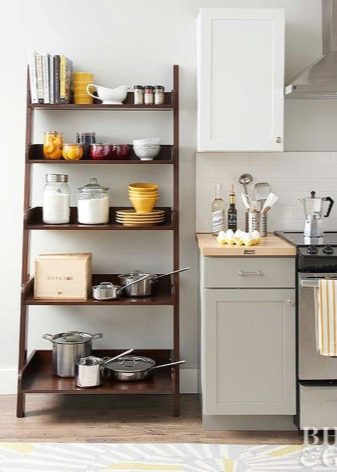
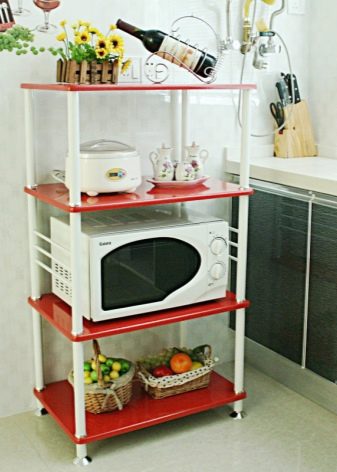
To learn how to make a Scandinavian-style wooden shelving unit, see the video.








